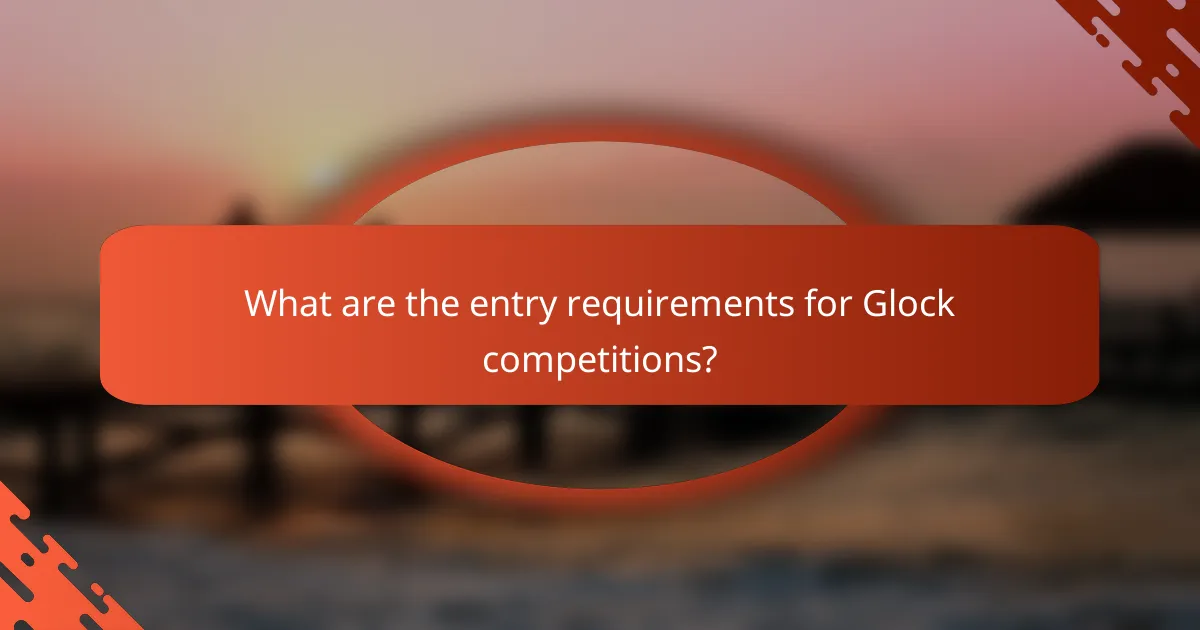Glock competitions in the United States offer a unique opportunity for enthusiasts to showcase their shooting skills in a structured environment. Participants can expect a dynamic atmosphere with various stages, strict safety protocols, and a strong sense of community, making these events suitable for shooters of all skill levels. To excel, it’s essential to prepare by honing your skills, understanding the rules, and ensuring you have the right gear for the competition.

What are the best Glock competitions in the United States?
The best Glock competitions in the United States include events that cater specifically to Glock enthusiasts, offering various formats and skill levels. These competitions provide a platform for shooters to showcase their abilities while adhering to specific rules and regulations associated with Glock firearms.
Glock Sport Shooting Foundation (GSSF) matches
The Glock Sport Shooting Foundation (GSSF) matches are designed for shooters of all skill levels, focusing on fun and safety. Participants can compete in a series of stages that test accuracy and speed using Glock pistols.
GSSF matches typically feature a variety of courses, including both indoor and outdoor settings. Competitors can expect to engage in scenarios that simulate real-life shooting situations, making it an excellent way to improve practical shooting skills.
USPSA Glock matches
The United States Practical Shooting Association (USPSA) hosts Glock matches that emphasize speed and precision in a competitive environment. These matches are structured around specific stages where shooters must navigate courses while engaging targets.
USPSA Glock matches often require participants to follow strict rules regarding equipment and scoring. Competitors are categorized based on skill level, allowing for fair competition among peers. It’s advisable to familiarize yourself with USPSA regulations before participating.
3-Gun competitions featuring Glock
3-Gun competitions are multi-gun events where participants use a combination of a rifle, shotgun, and pistol, including Glock handguns. These competitions challenge shooters to transition between firearms quickly and effectively while engaging various targets.
In 3-Gun competitions, Glock pistols are typically used for close-range engagements, while rifles and shotguns are utilized for longer distances. Competitors should practice transitioning between firearms and understand the specific rules of each event to excel in this dynamic format.

What can participants expect at Glock competitions?
Participants at Glock competitions can expect a dynamic environment featuring various shooting stages, strict safety protocols, and a strong sense of community. These events are designed to challenge shooters of all skill levels while fostering camaraderie among competitors.
Variety of shooting stages
Glock competitions typically include a range of shooting stages that test different skills, such as accuracy, speed, and tactical decision-making. Stages may involve shooting from various positions, engaging multiple targets, and navigating obstacles.
Competitors should prepare for diverse scenarios, which can include timed events and courses that simulate real-life situations. Familiarizing oneself with the layout and rules of each stage can greatly enhance performance.
Safety protocols and regulations
Safety is paramount at Glock competitions, with strict protocols in place to ensure the well-being of all participants. Common regulations include mandatory eye and ear protection, as well as clear guidelines on firearm handling and storage.
Participants should be aware of the specific rules governing their event, including any local laws regarding firearms. Following these protocols not only ensures safety but also contributes to a smooth competition experience.
Community and camaraderie
Glock competitions foster a strong sense of community among shooters, providing opportunities to connect with fellow enthusiasts. Participants often share tips, techniques, and experiences, enhancing their skills and enjoyment of the sport.
Engaging with others can lead to lasting friendships and networking opportunities within the shooting community. Many competitors find that the supportive atmosphere encourages personal growth and a deeper appreciation for the sport.

How to prepare for a Glock competition?
Preparing for a Glock competition involves honing your shooting skills, understanding the rules, and ensuring you have the right gear. Focus on practice, familiarize yourself with the competition structure, and create a checklist for your equipment.
Practice shooting techniques
Effective shooting techniques are crucial for success in Glock competitions. Spend time practicing various drills that enhance your accuracy, speed, and control. Focus on fundamentals like grip, stance, and trigger control, as these elements significantly impact your performance.
Incorporate timed drills to simulate competition conditions. For example, practice drawing from a holster and firing multiple shots within a set time limit. Aim to reduce your response time and improve your overall efficiency.
Understand competition rules
Familiarizing yourself with the specific rules of the Glock competition you plan to enter is essential. Each event may have different regulations regarding scoring, safety protocols, and equipment requirements. Review the official rulebook thoroughly to avoid disqualification.
Pay attention to details such as the types of allowed ammunition, magazine capacities, and any restrictions on modifications to your Glock. Knowing these rules will help you strategize and compete effectively.
Gear and equipment checklist
Having the right gear is vital for a successful competition experience. Start with a checklist that includes your Glock, extra magazines, ammunition, and safety gear like eye and ear protection. Ensure everything is in good working order before the event.
Consider additional items such as a reliable holster, a range bag for organization, and tools for quick adjustments. It’s also wise to bring snacks and hydration to maintain your energy during the competition.

What are the entry requirements for Glock competitions?
To participate in Glock competitions, entrants typically need to meet specific membership, age, and safety training requirements. These ensure that all competitors are adequately prepared and adhere to safety standards.
Membership in GSSF or USPSA
Competitors must be members of either the Glock Sport Shooting Foundation (GSSF) or the United States Practical Shooting Association (USPSA). Membership in these organizations provides access to competition resources, event notifications, and eligibility for various shooting events.
Joining GSSF often involves a nominal fee and offers benefits such as discounts on entry fees and access to exclusive competitions. USPSA membership also requires a fee and includes additional resources for practical shooting enthusiasts.
Age and safety training prerequisites
Participants in Glock competitions generally need to be at least 18 years old. However, younger shooters may compete if they have parental consent and are accompanied by an adult. Always check specific event rules as age requirements can vary.
Safety training is crucial; competitors are usually required to complete a recognized firearms safety course. This training ensures that all participants understand safe handling practices and competition rules, reducing the risk of accidents during events.

What gear is recommended for Glock competitions?
For Glock competitions, participants should focus on selecting the right firearm, accessories, and gear that enhance performance and comply with competition rules. Key considerations include the Glock model, essential modifications, and additional equipment that can improve accuracy and speed.
Glock models suitable for competition
Popular Glock models for competition include the Glock 34 and Glock 17, known for their longer barrels and improved sight radius, which enhance accuracy. The Glock 19 is also a favored choice due to its versatility and balance, making it suitable for various competition formats.
When selecting a model, consider the specific competition rules, as some events may have restrictions on modifications or specific models. It’s advisable to test different models to find the one that feels most comfortable and performs best for your shooting style.
Essential accessories and modifications
Key accessories for Glock competitions include high-capacity magazines, aftermarket sights, and enhanced trigger systems. Upgrading to adjustable sights can significantly improve aiming precision, while a lighter trigger pull can enhance shooting speed.
Other useful modifications include grip enhancements for better control and recoil management. Additionally, consider using a competition holster that allows for quick draws and secure retention, which is crucial during timed events.

What are the scoring systems used in Glock competitions?
Glock competitions typically utilize two main scoring systems: time-based scoring and hit factor scoring. Each system evaluates a competitor’s performance based on different criteria, influencing strategy and approach during the event.
Time-based scoring
In time-based scoring, the primary focus is on how quickly a competitor can complete a course of fire. The total time taken to finish the course is recorded, and the competitor with the shortest time wins. This system emphasizes speed, requiring shooters to balance quickness with accuracy.
Competitors should practice efficient movement and quick target acquisition to minimize their time. Common pitfalls include rushing shots, which can lead to misses or penalties, ultimately increasing the overall time. A good strategy is to familiarize oneself with the course layout beforehand to optimize movement and shooting positions.
Hit factor scoring
Hit factor scoring evaluates both accuracy and speed by calculating a score based on the number of hits and the time taken to achieve them. The formula typically involves dividing the total number of hits by the total time, resulting in a hit factor that determines placement. This system rewards precision as well as quick execution.
To excel in hit factor scoring, competitors should focus on making accurate shots while maintaining a reasonable pace. It’s crucial to avoid excessive misses, as they can significantly lower the hit factor. Practicing under timed conditions can help shooters find the right balance between speed and accuracy, ultimately improving their performance in competitions.

